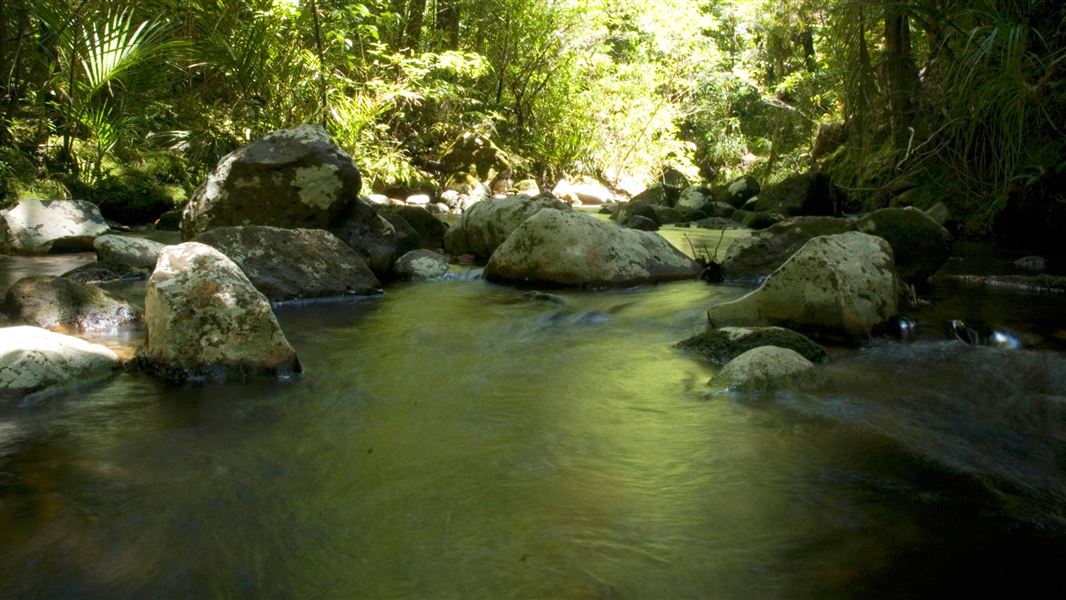Puketī and Omahuta forests are located between Northland's coastlines with the Hokianga Harbour in the west and the Bay of Islands on the east coast.
There are several places that you can access the recreational area from. The recommended entry point is from SH10 approximately 600 m north of the Waipapa Township.
Turn left along Pungaere Road past the sign directing you to the Puketī Forest Park. Follow Pungaere Road for approximately 15 km. Take care as part of the road is gravelled. At a T-intersection, turn left, follow the road for about 2 km. The entrance of the recreational area will be on your right.
The cabins are immediately adjacent to the Puketī Forest Hut.
If using alternative routes, refer to local maps as there is no DOC signage at other possible entry points to the Puketī Forest.
-
Leaving vehicles at road ends over night is not advisable due to the risk of theft.
-
For longer tramps NZTopo50 maps are essential.
-
No dogs due to risks to wildlife.
More information on Puketi Forest Trust site.
Camping
Apple Tree Dam Campsite is closed for the protection of kauri.
There is a camp area on Blackbridge Road where water is available. Boil water before drinking. During dry seasons this water can run low so top up before walking the trail through to the campsite.
Closed tracks
Some tracks in the forests have been permanently closed to prevent the spread of kauri disease and protect our kauri.
Map of Puketi Forest closures (PDF, 471K)
At more than 21,000 ha, this forest tract is the second largest but most intact forested habitat in the Eastern Northland Ecological Region. DOC administers 16,210.7 ha, with 250.2 ha under Conservation Covenant and 427.6 ha under covenant with the Queen Elizabeth II National Trust.
With over 360 indigenous species of plants, this forest is one of the most diverse in New Zealand. It supports nine threatened fauna species and several others which are endemic, or regionally significant.
The mature kauri forest remnants are especially important in that less than 1% of the original cover of this forest type is left (Northland CMS). The lowland mixed kauri forest is one of the best remaining examples of this type.
Vegetation
Taraire forest occurs over large areas of Puketī-Omahuta Forest. Puriri, towai, totara and kahikatea are sometimes frequent. Northern rata and kahikatea are occasionally emergent in the canopy with rewarewa, rimu, tanekaha, kauri, pukatea, hinau, mamaku tree fern, tawa, and nikau also being present.
Fauna
Bird species found here include North Island brown kiwi, kōkako, NZ pigeon/kukupa, pied tit, banded rail, and fernbird. The forests are also home to short-tailed and long-tailed bats, Pacific gecko, and Northland green gecko. You can also find Northland tusked weta, Kauri snail, and native fish including banded kokopu, and koaro.
Landform/geology
Dissected horst of Waipapa Group greywacke and minor basalt, capped by outliers of Te Kuiti Group calcareous mudstone and glauconitic sandstone, Mangakahia Complex mudstone and Kerikeri Volcanics basalt flows.
Stop kauri disease and protect kauri
- Scrub all soil off shoes and gear.
- Use cleaning stations.
- Always stay on the track.
DOC Customer Service Centre
| Phone: | 0800 275 362 |
| Email: | bayofislands@doc.govt.nz |
| Address: | Pewhairangi / Bay of Islands Office |
